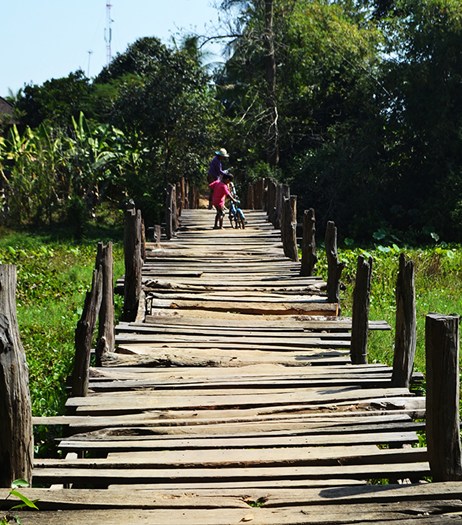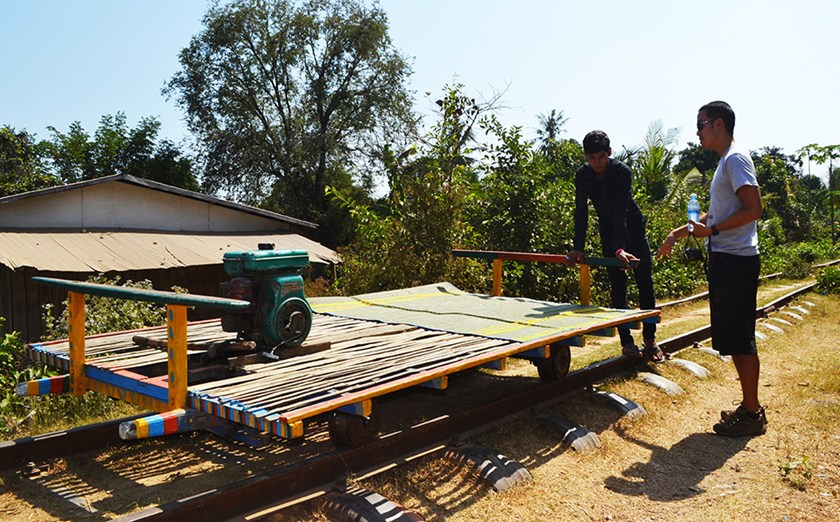BATTAMBANG, CAMBODIA - The narrow bridge does not inspire confidence. It is made of wooden planks laid beside each other with conspicuous gaps between them. At the other end, a child takes no chances and walks her bicycle, rather than riding it.
“Maybe you should get off,” Weh says.
So I hop off the motorbike from the left, careful to avoid the exhaust pipe on the bike’s right side. Weh slowly drives across the bridge as I follow behind.
We’re searching for a bamboo train outside of Battambang, a provincial capital in northwestern Cambodia. Often overlooked for the flashier Cambodian cities of Phnom Penh and Siem Reap, Battambang nonetheless has much to offer travellers willing to stray from the usual tourist sites.
The small city was the centre of Cambodian arts before the genocidal Khmer Rouge killed most of this country’s artists in the 1970s. Today, there’s an arts resurgence in Cambodia, and Battambang’s arts school is at the heart of it.
The city also offers the chance to see temples without the hordes of tourists that crowd Siem Reap’s Angkor Wat, and its beautiful French colonial buildings and excellent restaurants make it a relaxing place to experience the best of Cambodia. Art, culture, temples, food – Battambang has it all — and Weh and I are determined to see as much of it as possible in one day.
Our quest to find the bamboo train is slowing us down, however. It is difficult to find. Every so often, Weh stops to ask for directions in Cambodian. Though it’s a Saturday, children in white and blue school uniforms walk along the dusty roads. Many of them wave and call “hello!” excited to see foreigners in their midst.
Weh stops again to ask for directions. After a brief exchange, he turns to me and says, “They say it’s here.”
“Here” is an unremarkable spot. There are a few simple huts on either side of railroad tracks I would have passed without noticing. Two men assemble the train, setting four train wheels on the tracks and placing a simple bamboo frame on top. The contraption is powered by what looks like a motor found in a garden tractor.
It’s simple, but it works. We fly through the bush, passing ponds and wooden homes, the sun shining and the wind whipping past us. When we meet a Cambodian family going the other way, we slow to a stop. The conductor on the other train helps our conductor remove our train from the tracks to let the others pass.


Above: Old bridges and old an old railway link this community together.
Later, I learn there’s a bamboo train closer to the city, where tourists are greeted by tourist police and children selling bracelets and knickknacks. Weh and I found a more remote stop, where Cambodians use the train to ship supplies and to get from point A to point B.
After our ride is over, we move to the next thing on our itinerary: Wat Banan, an 11th-century temple on Phnom Banan (Banan Mountain). After a quick ride to the mountain, it takes 360 steps to get to the temple at the top. Children fan out-of-breath tourists making the climb.
At the top, crumbling stone temples overlook flat rice fields. Weh and I hear music from either a wedding or funeral in the distance. In Cambodia, both are infamous for their volume. Given we can hear it at the top of a mountain, this ritual is living up to its loud reputation.
By the time we’ve gone back down the 360 stairs, I’ve worked up an appetite. Weh eggs me on to try fried crickets, and I buy a small plastic bag from a woman who speaks no English. The crickets’ eyes are huge; I can’t look at them directly as I pop them into my mouth.
They’re crunchy and full of flavour. An unexpectedly good snack.
.jpg)
Above: Our writer feasts on the local cuisine.
It’s off to our next mountain, Phnom Sampeau, which is much bigger than Phnom Banan, and we spend a few hours exploring. Its temples are painted cheerful blue, red and gold, but its caves are sobering.
They’re called killing caves, because they’re the site of widespread executions at the hands of the Khmer Rouge.
Before dusk, we return to the bottom of the mountain where a crowd has gathered to face an opening in one of the caves. As the sun drops lower in the sky, thousands upon thousands of bats stream from the cave. The crowd is silent as it takes in the awesome sight, which happens every evening at the mountain.
Weh and I don’t have time to linger, however. We’ve got a circus to see. We ride back to Battambang, making it just in time for the circus performance at Phare Ponleu Selpak, the arts school. Under the big top, students of the performing arts treat us to a dramatic telling of how the school was established by Cambodian refugees.
With a tightrope, fire dancing, and daring acrobatic displays, the circus performers show what life was like under the Khmer Rouge and how art helped Cambodian refugees cope with trauma as they stayed in a camp on the Thai-Cambodian border. Upon their repatriation to Cambodia, a number of students formed Phare Ponleu Selpak. Now Cambodians and tourists alike enjoy the school’s impressive and poignant performances.
In the course of a day, Weh and I have visited a bamboo train, temples, killing caves and the circus. We’ve eaten crickets and seen a parade of bats. But our busy day is not yet over. When we leave the circus, Weh gives me a quick lesson on how to drive a motorbike.
The lesson ends with me in the ditch, the front of the bike scratched by a barbed wire fence.
It’s a memorable end to an already memorable day in Battambang, an underrated city I know I will be returning to again and again.
About the Author
Allison Jane Smith is a writer who once moved to Cambodia on a whim. She spent two years in Southeast Asia, traveling and writing for publications like Matador Network, Nowhere, TakePart World, and others. Now back in Canada, she writes about politics, travel, and social change. You can follow Allison on Twitter: @asmithb